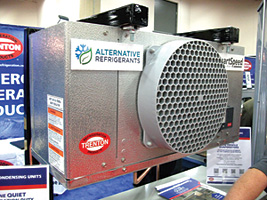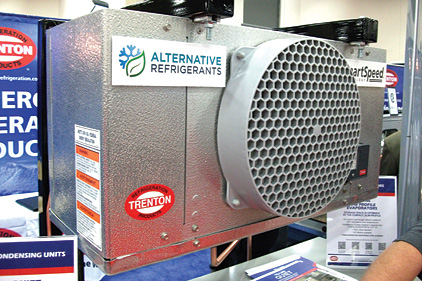DALLAS — About a month before the AHR Expo, the U.S. Environmental Protection Agency (EPA) indicated it would permit the industry to produce and import 39 million pounds of virgin HCFC-22 in 2013, down from 55 million pounds in 2012.
The number was not hard and fast, but early indications were that this would be the total amount of new R-22 the industry would be allowed to bring to the market. A foregone conclusion was an increase in cost of the refrigerant. But the question as to supplies through 2013 was not as certain.

|
|
Issues with supplies of R-22 have intensified interest in a wide range of alternative refrigerants as indicated by this signage at the booth of Trenton Refrigeration at the AHR Expo in Dallas. |
It took a walk along the show floor at the AHR Expo this January in Dallas to make things a bit clearer. The clarification came from informal comments, as well as formal statements, from refrigerant manufacturers, as well as other interested parties.
Informally, the feeling was that the industry would manage just fine with the given 2013 R-22 supply. This included the new R-22 coming to market, used R-22 submitted for reclamation, and recovered and reintroduced R-22, which an owner may pull from a decommissioned or retrofitted system and introduce to another system that is owned by the same person.
Regardless of the EPA limitation, manufacturers, at the AHR Expo, continued to stress the reality that no matter the short-term supplies of R-22, there will be an eventual shortfall — most likely well before 2020 — when no new R-22 will be produced or imported.
Gordon McKinney of ICOR Intl. acknowledged that this shortfall will likely occur sooner than later. “Many realized that R-22 would no longer be the most practical option for maintaining the enormous amount of R-22 systems in operation today,” he said.
He was referencing the EPA’s ‘No Action Assurance’ letters issued a few weeks before the expo, which in effect said that the industry would not face fines if new R-22 production and importation remained at 39 million pounds or less.
McKinney said, “Within hours of the news, the market reacted with substantial price increases and new allocation policies were rolled out at all levels, and in every sector of the industry. The reaction was very similar to last year’s deep cuts by the EPA. However, the consensus is that 2013 will be the first year we will not have enough R-22 to satisfy the industry’s service requirements. This notion is quickly sinking in with distributors and their refrigerant customers as attention and interest refocus on new equipment, reclaimed gas, and, most importantly, the alternative refrigerant options.”
Inside the booth of National Refrigerants, representatives questioned if spot shortages could become problematic. The company’s Maureen Beatty said she believed R-22 supplies, in some cases, could be spotty. “Every wholesaler will not have R-22 to sell, and some who have it will not have as much as they had previously.”
Reclamation and Alternatives
Reclamation of R-22 and the use of HFC retrofit alternatives served as the focal point of floor discussion.
Regarding reclamation, Airgas’ Jay Kestenbaum said, “The industry does have the tools in place to recover and reclaim substantially greater amounts than are currently being put through industry reclamation facilities. We are confident that with the additional new push by the EPA, all users will realize how necessary it is to recover every pound in order to provide the inventory that will be needed for many years,” he said.
In a statement issued at the expo, DuPont Refrigerants’ Jim Bachman said, “There are significant reductions in R-22 supply, indicating an immediate need for refrigerant-management planning including retrofit to R-22 alternatives and refrigerant recovery and reclaim.
“We have worked with the industry throughout the R-22 phaseout, and will continue to do so,” said Bachman. “DuPont has an active refrigerant recovery and reclaim program; however, the rate of reclaim seen by the industry in recent years will not be sufficient to fill the gap in available R-22. Other steps including service practice improvements and retrofits to R-22 alternatives are needed to accelerate the move away from R-22.”
Also offering alternative refrigerant information was Honeywell, which, like a number of refrigerant manufacturers, was promoting available HFC retrofit replacements for R-22.
Whatever the retrofit, refrigerant manufacturer Arkema, which has its own line of HFC retrofits, offered some cautions. “Today, many in our industry are faced with selecting R-22 retrofits from a large and growing list of options,” said Arkema’s Stephen Spletzer, who conducts regular seminars on the topic. “While many of these products claim to be drop-ins, direct replacements, or easy to use, the fact is there are no simple solutions. Training is vital to ensuring quality service throughout this transition.”
Publication date: 3/4/2013



Report Abusive Comment